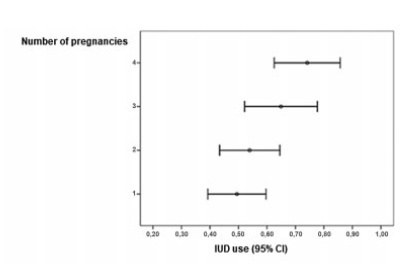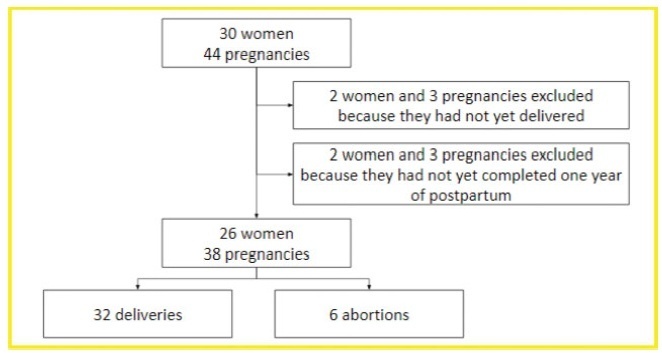-
Original Article
Prevalence of Screening for Diabetes Mellitus in Patients Previously Diagnosed with Gestational Diabetes: Factors Related to its Performance
Revista Brasileira de Ginecologia e Obstetrícia. 2022;44(11):1032-1039
02-03-2022
Summary
Original ArticlePrevalence of Screening for Diabetes Mellitus in Patients Previously Diagnosed with Gestational Diabetes: Factors Related to its Performance
Revista Brasileira de Ginecologia e Obstetrícia. 2022;44(11):1032-1039
02-03-2022Views109See moreAbstract
Objective
To determine how many patients underwent screening for diabetes mellitus (DM) in the puerperium after a diagnosis of gestational DM (GDM) and which factors were related to its performance.
Methods
The present is a prospective cohort study with 175 women with a diagnosis of GDM. Sociodemographic and clinico-obstetric data were collected through a questionnaire and a screening test for DM was requested six weeks postpartum. After ten weeks, the researchers contacted the patients by telephone with questions about the performance of the screening. The categorical variables were expressed as absolute and relative frequencies. The measure of association was the relative risk with a 95% confidence interval (95%CI), and values of p ≤ 0.05 were considered statistically significant and tested through logistic regression.
Results
The survey was completed by 159 patients, 32 (20.1%) of whom underwent puerperal screening. The mean age of the sample was of 30.7 years, and most patients were white (57.9%), married (56.6%), and had had 8 or more years of schooling (72.3%). About 22.6% of the patients used medications to treat GDM, 30.8% had other comorbidities, and 76.7% attended the postnatal appointment. Attendance at the postpartum appointment, the use of medication, and the presence of comorbidities showed an association with the performance of the oral glucose tolerance test in the puerperium.
Conclusion
The prevalence of screening for DM six weeks postpartum is low in women previously diagnosed with GDM. Patients who attended the postpartum consultation, used medications to treat GDM, and had comorbidities were the most adherent to the puerperal screening. We need strategies to increase the rate of performance of this exam.
-
Original Article
Knowledge, Attitude, and Practice of Brazilian Physicians about Immediate Postpartum and Postabortion Intrauterine Device Insertion
Revista Brasileira de Ginecologia e Obstetrícia. 2023;45(9):524-534
00-00-2023
Summary
Original ArticleKnowledge, Attitude, and Practice of Brazilian Physicians about Immediate Postpartum and Postabortion Intrauterine Device Insertion
Revista Brasileira de Ginecologia e Obstetrícia. 2023;45(9):524-534
00-00-2023Views112Abstract
Objective
To assess the knowledge, attitude, and practice of Brazilian physicians about immediate postpartum and postabortion intrauterine device insertion.
Methods
Cross-sectional online survey involving physicians on duty in public Brazilian hospitals. Participants answered an anonymous questionnaire with close-ended questions to assess their knowledge, attitude, and experience on the immediate postpartum and postabortion insertion of copper intrauterine devices.
Results
One hundred twenty-seven physicians working in 23 hospitals in the 5 geographic regions of Brazil completed the questionnaire. Most were female (68.5%) and worked in teaching hospitals (95.3%). The mean (standard deviation) knowledge score (0–10 scale) was 5.3 (1.3); only 27.6% of the participants had overall scores ≥7.0. Most physicians (73.2%) would insert a postpartum intrauterine device in themselves/family members. About 42% of respondents stated that they had not received any training on postpartum or postabortion intrauterine device insertion. In the past 12 months, 19.7%, 22.8%, and 53.5% of respondents stated they had not inserted any intrauterine device during a cesarean section, immediately after a vaginal delivery, or after an abortion, respectively.
Conclusion
Most study participants have a positive attitude toward the insertion of intrauterine devices in the immediate postpartum period, but they have limited knowledge about the use of this contraceptive method. A large percentage of respondents did not have previous training on postpartum and postabortion intrauterine device insertion and had not performed any such insertions in the last 12 months. Strategies are needed to improve the knowledge, training, and experience of Brazilian physicians on immediate postpartum and postabortion intrauterine device insertion.
Key-words attitudescopper intrauterine deviceshealth knowledgeinduced abortionPostpartum periodpracticeSpontaneous abortionSee more -
Original Article
Increment of Maternal Mortality Among Admissions for Childbirth in Low-risk Pregnant Women in Brazil: Effect of COVID-19 Pandemic?
Revista Brasileira de Ginecologia e Obstetrícia. 2022;44(8):740-745
07-07-2022
Summary
Original ArticleIncrement of Maternal Mortality Among Admissions for Childbirth in Low-risk Pregnant Women in Brazil: Effect of COVID-19 Pandemic?
Revista Brasileira de Ginecologia e Obstetrícia. 2022;44(8):740-745
07-07-2022Views118See moreAbstract
Objective
To assess the possible impact of the COVID-19 pandemic on maternal mortality among admissions for childbirth in 2020 in relation of the last 10 years.
Methods
An ecological study with pregnant women who underwent hospital births at the Brazilian unified public health service (SUS, in the Portuguese acronym) in Brazil from 2010 to 2020. The mortality among admissions for childbirth was obtained based on the number of admissions for childbirth with reported death as outcome divided by the total number of admissions. The underlying gestational risk and route of delivery were considered based on the national surveillance system. The average mortality for the period between 2010 and 2019 (baseline) was compared with the rate of deaths in 2020 (1st pandemic year); the rate ratio was interpreted as the risk of death in 2020 in relation to the average of the previous period (RR), with 95% confidence intervals (CIs).
Results
In 2020, the 1st year of the COVID-19 pandemic, 1,821,775 pregnant women were hospitalized for childbirth and 651 deaths were reported, which represents 8.7% of the total hospitalizations and 11.3% of maternal deaths between 2010 and 2020. There was an increase in maternal mortality after births in 2020 compared with the average for the period between 2010 and 2019, specially in low-risk pregnancies, both in vaginal (RR = 1.60; 95%CI:1.39–1.85) and cesarean births (RR = 1.18; 95%CI:1.04–1.34).
Conclusion
Maternal mortality among admissions for childbirth according to SUS data increased in 2020 compared with the average between 2010 and 2019, with an increment of 40% in low-risk pregnancies. The increase was of 18% after cesarean section and of 60% after vaginal delivery.
-
Original Article
Immediate Postpartum Copper IUD: A Comparative Analysis between Profiles of Women who Accept and who Refuse it
Revista Brasileira de Ginecologia e Obstetrícia. 2022;44(2):154-160
04-08-2022
Summary
Original ArticleImmediate Postpartum Copper IUD: A Comparative Analysis between Profiles of Women who Accept and who Refuse it
Revista Brasileira de Ginecologia e Obstetrícia. 2022;44(2):154-160
04-08-2022Views128Abstract
Objective
To analyze the profiles of women who accepted and who refused the insertion of the copper intrauterine device (IUD) postpartum and to learn the motivations related to the refusal of the method.
Methods
Cross-sectional study with 299 pregnant women. The women were informed about the possibility of inserting a copper IUD postpartum and were questioned about their interest in adopting or not this contraceptive. All participants answered a questionnaire with information relevant to the proposals of the present study. The sample size was limited to the number of devices available for the present study.
Results
A total of 560 women were invited to join the present study and 299 accepted. Out of the 299 women included in the present study, 175 accepted the copper IUD and 124 refused. As the number of pregnancies increased, the IUD acceptance rate raised (p=0.002), especially between the groups with 1 and with ≥ 4 pregnancies (p=0.013). Regarding the desire to havemore children, the women who planned to have more children were more likely to refuse the method than the ones who did not (p<0,001).
Conclusion
Women with multiple pregnancies and desire to not have more children were more likely to accept the copper IUD. The profile of those who refused was first pregnancy and desire to have more children. Among the three most frequent reasons reported for copper IUD rejection, two responses stood out: no specific justification and desire to have more children.
Key-words Contraceptioncopper intrauterine deviceFamily planning servicesIntrauterine devicesPostpartum periodSee more
-
Original Article
Screening of Perinatal Depression Using the Edinburgh Postpartum Depression Scale
Revista Brasileira de Ginecologia e Obstetrícia. 2022;44(5):452-457
03-04-2022
Summary
Original ArticleScreening of Perinatal Depression Using the Edinburgh Postpartum Depression Scale
Revista Brasileira de Ginecologia e Obstetrícia. 2022;44(5):452-457
03-04-2022Views298See moreAbstract
Objective
To detect depression during pregnancy and in the immediate postpartum period using the Edinburgh postpartum depression scale (EPDS).
Methods
Cross sectional study of 315 women, aged between 14 and 44 years, who received perinatal care at the Leonor Mendes de Barros Hospital, in São Paulo, between July 1st, 2019 and October 30th, 2020. The cutoff point suggesting depression was ≥ 12.
Results
The screening indicated 62 (19.7%) patients experiencing depression. Low family income, multiparity, fewer prenatal appointments, antecedents of emotional disorders, dissatisfaction with the pregnancy, poor relationship with the partner, and psychological aggression were all risk factors associated with depression in pregnancy or in the immediate postpartum period. Antecedents of depression and psychology aggression during pregnancy were significant variables for predicting perinatal depression in the multivariate analysis.
Conclusion
There is a significant association between the occurrence of perinatal depression and the aforementioned psychosocial factors. Screening patients with the EPDS during perinatal and postpartum care could facilitate establishing a line of care to improve the wellbeing of mother and infant.
-
Review Article
Dyspnea and COVID-19: A Review of Confounding Diagnoses during the Postpartum Period
Revista Brasileira de Ginecologia e Obstetrícia. 2021;43(11):862-869
01-12-2021
Summary
Review ArticleDyspnea and COVID-19: A Review of Confounding Diagnoses during the Postpartum Period
Revista Brasileira de Ginecologia e Obstetrícia. 2021;43(11):862-869
01-12-2021Views143See moreAbstract
The puerperium is a complex period that begins with placental delivery and lasts for 6 weeks, during which readaptation of the female organism and redistribution of blood volume occur. This period is conducive to the occurrence of thromboembolic events. In the context of the SARS-CoV-2 pandemic, the virus responsible for COVID-19, the attention of the scientific community and health professionals has been focused on obtaining insights on different aspects of this disease, including etiology, transmission, diagnosis, and treatment. Regarding the pregnancy-postpartum cycle, it is opportune to review the clinical conditions that can occur during this period and to investigate dyspnea as a postpartum symptom in order to avoid its immediate association with COVID-19 without further investigation, which can lead to overlooking the diagnosis of other important and occasionally fatal conditions.
-
Original Article
Disease Progression and Obstetric Outcomes of Women with Multiple Sclerosis at a Reference Center in Northeastern Brazil
Revista Brasileira de Ginecologia e Obstetrícia. 2021;43(3):165-171
05-24-2021
Summary
Original ArticleDisease Progression and Obstetric Outcomes of Women with Multiple Sclerosis at a Reference Center in Northeastern Brazil
Revista Brasileira de Ginecologia e Obstetrícia. 2021;43(3):165-171
05-24-2021Views166See moreAbstract
Objective
To describe the obstetric outcomes of patients withmultiple sclerosis (MS) and the impact of pregnancy and the postpartum period on the progression of the disease.
Methods
A case series study performed between December 2019 and February 2020, reporting pregnancies occurred between 1996 and 2019. The subjects included were women with MS undergoing follow-up at an MS referral center in Northeastern Brazil, and who had at least one pregnancy after the onset of MS symptoms, or who had their first relapse in the first year after delivery.
Results
In total, 26 women and 38 pregnancies were analyzed - 32 of them resulted in delivery, and the remaining 6, in miscarriages. There was a significant increase in the prevalence of relapse during the postpartum period when compared with the gestational period. In 16 (42.1%) of the pregnancies, there was exposure to diseasemodifying therapies (DMTs) - 14 (36.8%), to interferon β, and 2 (5.3%), to fingolimod. Higher rates of abortion, prematurity and low birth weight were reported in the group was exposed to DMT when compared with the one who was not.
Conclusion
In the sample of the present study, there was a significant increase in the rate of MS relapse during the postpartum period when compared with the gestational period. Additionally, it seems that exposure to DMTs during pregnancy may affect the obstetric outcomes of the patients.



